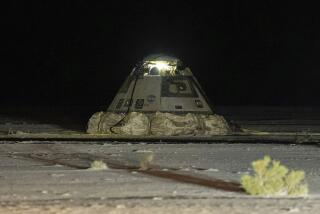Discovery Crew Begins Final Simulation
- Share via
HOUSTON — The crew members of the shuttle Discovery fought off a make-believe engine failure and other deliberate malfunctions Tuesday in their final flight simulation before the launch of the first post-Challenger mission.
Commander Frederick H. Hauck, co-pilot Richard O. Covey and mission specialists John M. Lounge, George D. Nelson and David C. Hilmers “blasted off” in the Johnson Space Center’s shuttle simulator about an hour late because of technical problems, NASA officials said.
The 56-hour simulation marks a final chance for the astronauts and flight controllers to practice procedures in detail before Discovery is launched from the Kennedy Space Center in Florida.
Wage ‘Mental Battle’
“The people who do the simulation, the ‘sim’ supervisors, sort of wage a mental battle with the flight controllers,” spokesman Brian Welch said. “They will do everything they can to make it more difficult. They try to throw a problem at each major (flight) system.”
Lounge and Nelson may have to wear spacesuits to wrestle a mock satellite in the space center water tank, the crew may be asked to make an unplanned landing, and early deployment of a $100-million NASA communications satellite may be thrown off schedule during the test.
The rehearsal was scheduled to end Thursday afternoon, and a full day of debriefing will follow, Welch said.
Meanwhile, the National Aeronautics and Space Administration on Tuesday revised its schedule of shuttle flights, bumping the launch of the $1.4-billion Hubble Space Telescope into 1990 to accommodate defense-related missions and two interplanetary probes.
50 Shuttle Flights
The schedule, last updated in March, envisions 50 shuttle flights through the autumn of 1993, starting with the launch of Discovery in late September or early October.
The Magellan mission to Venus, now scheduled for April, 1989, and the Galileo mission to Jupiter in October, 1989, are unchanged under NASA’s new schedule. Both missions involve relatively narrow launch “windows” that must be met before changing planetary alignments force delays.
The space telescope, which NASA had hoped to launch in June, 1989, would be pushed back to February, 1990. NASA said the delay was needed to make sure the shuttle will meet its commitments to the Pentagon and still accommodate the fixed dates for the interplanetary missions.
More to Read
Sign up for Essential California
The most important California stories and recommendations in your inbox every morning.
You may occasionally receive promotional content from the Los Angeles Times.










